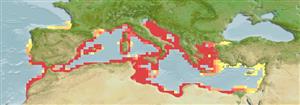Gastropoda |
Neogastropoda |
Muricidae
Environment: milieu / climate zone / εύρος βάθους / distribution range
Οικολογία
; εύρος βάθους 1 - 200 m (Αναφ. 105998). Subtropical, preferred 20°C (Αναφ. 107945); 45°N - 30°N, 10°W - 36°E
Eastern Atlantic and the Mediterranean: from Portugal to central Morocco in the Atlantic, and east to Lebanon. Introduced in Atlantic Spain.
Length at first maturity / Μέγεθος / Weight / Age
Γεννητική Ωρίμανση: Lm 5.6, range 4 - ? cm Max length : 10.8 cm ShL αρσενικό/απροσδιόριστο; (Αναφ. 127250); μεγ. δημοσιευμένο βάρος: 79.70 g (Αναφ. 127250)
Has high economic value since ancient times because it is used to produce a purple dye (Refs. 78459, 78460 and 78461). Carnivorous and feeds on bivalves and other gastropods (Ref. 2532).
Showed an annual reproductive cycle in the Catalan coast. The reproductive cycle had two peaks (April and June -July) but the first one seems to be less important because the number of immature females is higher than the mature ones.
Museum of Natural History in Paris 2005 CLEMAM - Checklist of European Marine Mollusca - Public scientific database, consulted on [020606], hosted by Muséum National d'Histoire Naturelle (M.N.H.N.), Paris, at: http://www.mnhn.fr/biotaxis/clemam. Muséum National d'Histoire Naturelle (M.N.H.N.), Paris, at: http://www.mnhn.fr/biotaxis/clemam (Αναφ. 1056)
IUCN Red List Status
(Αναφ. 130435: Version 2025-1)
CITES status (Αναφ. 108899)
Not Evaluated
Not Evaluated
Threat to humans
Human uses
αλιεία: Εμπορικό(ά)
| FishSource | Η θάλασσα γύρω μας
Εργαλεία
Περισσότερες πληροφορίες
PhysiologyΚατανάλωση οξυγόνου
Διαδικτυακές πηγές
Estimates based on models
Preferred temperature
(Ref.
115969): 16.2 - 21.6, mean 19.3 (based on 132 cells).
Prior r = 1.01, 95% CL = 0.67 - 1.52, Based on 2 full stock assessments.
Fishing Vulnerability
Low vulnerability (10 of 100).
Climate Vulnerability
Very high vulnerability (77 of 100).
Price category
Unknown.
Nutrients : Calcium = 126 [75, 177] mg/100g; Iron = 4.79 [1.67, 7.92] mg/100g; Protein = 15.9 [14.8, 16.9] %; Omega3 = 0.331 [0.263, 0.400] g/100g; Selenium = 57.8 [48.5, 67.2] μg/100g; VitaminA = 0 μg/100g; Zinc = 1.97 [0.92, 3.02] mg/100g (wet weight); based on
nutrient studies.
